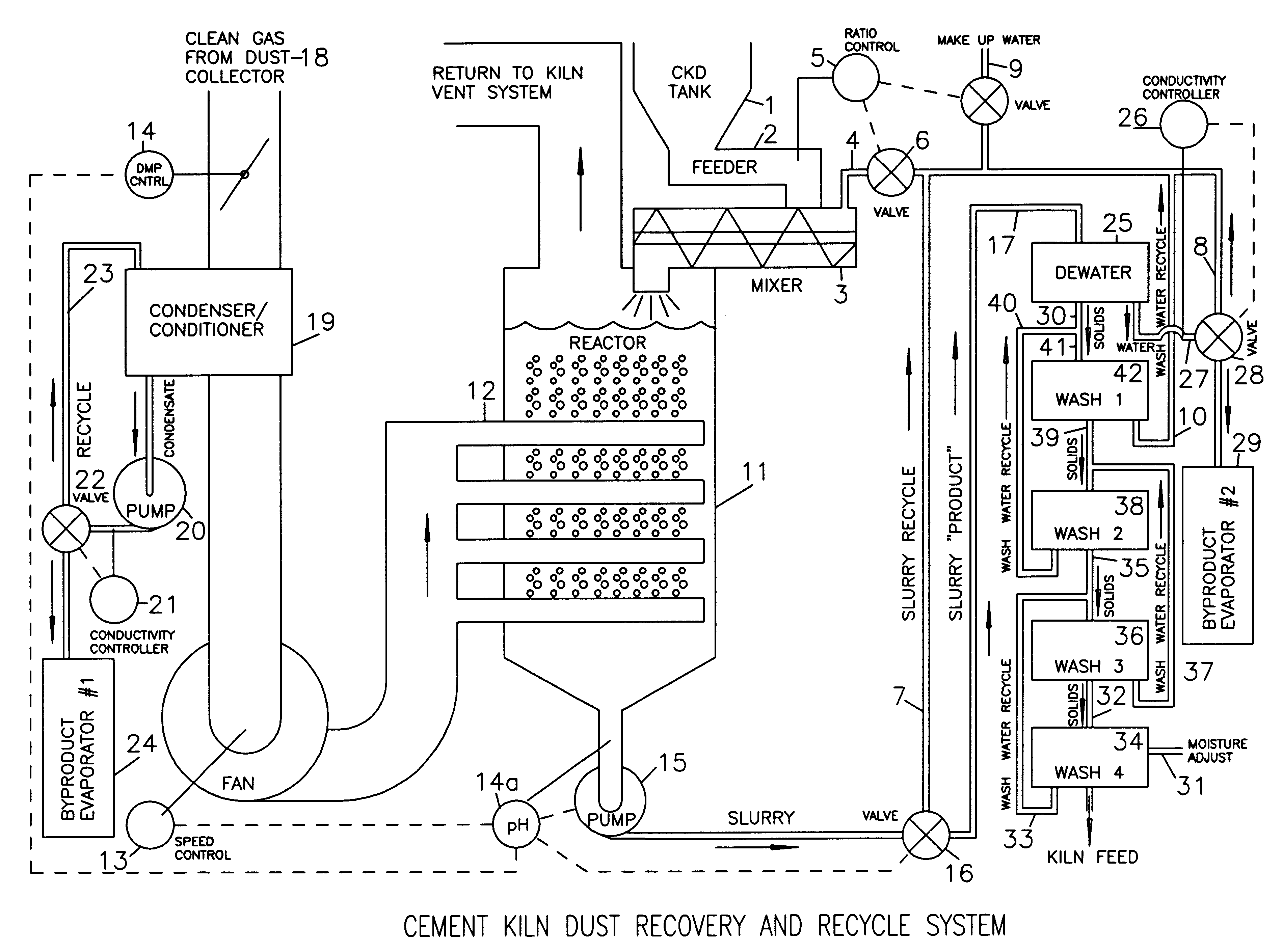Method of treating cement kiln dust for recovery and recycle
a cement kiln dust and recycling technology, applied in the field of ckd, can solve the problems of no commercially viable ckd reclaim and recycle facility in the united states, detrimental to the biosphere of ph effluent, and a large ban on leaching methods in the pas
- Summary
- Abstract
- Description
- Claims
- Application Information
AI Technical Summary
Problems solved by technology
Method used
Image
Examples
example 1
A simplified "dust" was investigated in a sulfate / water system. In ordinary cement kiln dust, K.sub.2 SO.sub.4 constitutes the bulk of the readily soluble material, while free CaO is the most active constituent. Uncalcined raw mix is essentially inert in water, while clinker compounds are significantly less reactive than free CaO and less soluble than K.sub.2 SO.sub.4. This simplified system permits ready identification of precipitates in the system by eliminating interferences caused by other compounds which are ordinarily present in actual kiln dust.
Tests were conducted using K.sub.2 SO.sub.4 solutions of various concentrations between 2 and 25 grams per liter (g / l) to which were added varying amounts of CaO, between 0 and 50 g / l. The resulting mixtures were allowed to stand for varying periods of time from 10 minutes to 18 hours and at various temperatures from 20.degree. to 100.degree. C. After 18 hours of standing, the results indicated that relatively weak solutions of K.sub.2...
example 2
When carbon dioxide (CO.sub.2) was added to the systems in Example 1 in the temperature range of 20.degree. C. to 100.degree. C., calcium carbonate (CaCO.sub.3) precipitated. Since CaCO.sub.3 is two orders of magnitude less soluble than the calcium sulfates (0.01 to 0.02 g / l as opposed to 2 to 3 g / l), the calcium is effectively tied up, thereby freeing alkalies and sulfate to the solution. This result is in contrast to the result in the CO.sub.2 -free system, where various calcium compounds precipitate, including K.sub.2 Ca(SO.sub.4).sub.2.H.sub.2 O.
X-ray diffraction identification of the precipitated solids showed Ca(OH).sub.2, K.sub.2 Ca(SO.sub.4).sub.2.H.sub.2 O, CaSO.sub.4.2 H.sub.2 O, and CaSO.sub.4.1 / 2H.sub.2 O when the system was not carbonated. When the system was fully carbonated, CaCO.sub.3 was essentially the only solid phase present. Samples of solids taken in progression during carbonation showed that early precipitated sulfate phases, including K.sub.2 Ca(SO.sub.4).sub...
example 3
In order to determine the optimum amount of carbonation to which an actual kiln dust should be subjected prior to separating the slurry into solids and brine, a series of tests were run. One test slurry composed of one part dust and five parts water was maintained at a temperature of 23.degree. C., CO.sub.2 was bubbled continuously therethrough, and the concentration of dissolved CaO in g / l of solution was measured. Results of this test are shown in FIG. 4. The line above pH of 9.5 represents a curve derived from that test. The line between pH of 7.5 and 9.5 is derived from a similar test with a dust-to-water ratio of 1 part dust to 3 parts water and maintained at a temperature of 23.degree. C. The results are in accord with well-known solubility and alkalinity data. It is evident that a minimum solubility of CaO occurs at pH 9.5 at 23.degree. C. At pH above 9.5, under-carbonation exists with the presence of OH.sup.- ions, while at a pH below 9.5 over-carbonation exists with the pre...
PUM
| Property | Measurement | Unit |
|---|---|---|
| temperature | aaaaa | aaaaa |
| temperature | aaaaa | aaaaa |
| pressure | aaaaa | aaaaa |
Abstract
Description
Claims
Application Information
 Login to View More
Login to View More - R&D
- Intellectual Property
- Life Sciences
- Materials
- Tech Scout
- Unparalleled Data Quality
- Higher Quality Content
- 60% Fewer Hallucinations
Browse by: Latest US Patents, China's latest patents, Technical Efficacy Thesaurus, Application Domain, Technology Topic, Popular Technical Reports.
© 2025 PatSnap. All rights reserved.Legal|Privacy policy|Modern Slavery Act Transparency Statement|Sitemap|About US| Contact US: help@patsnap.com



